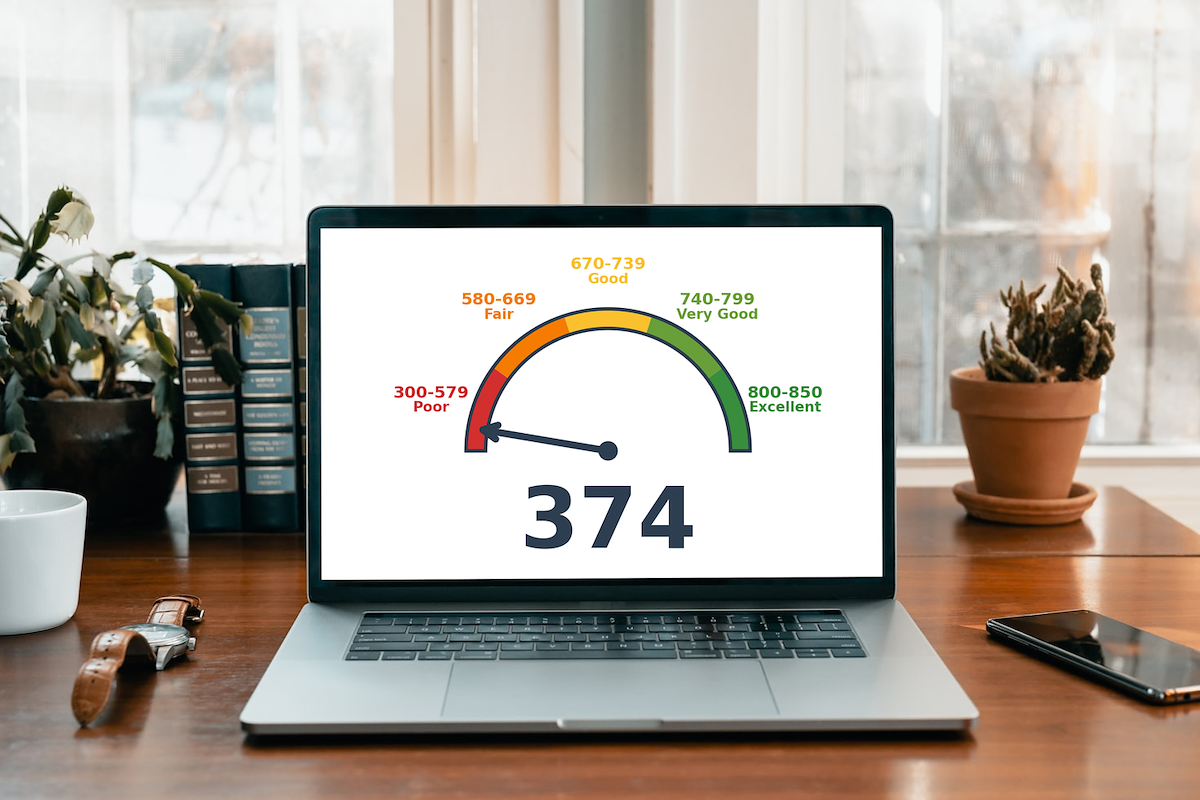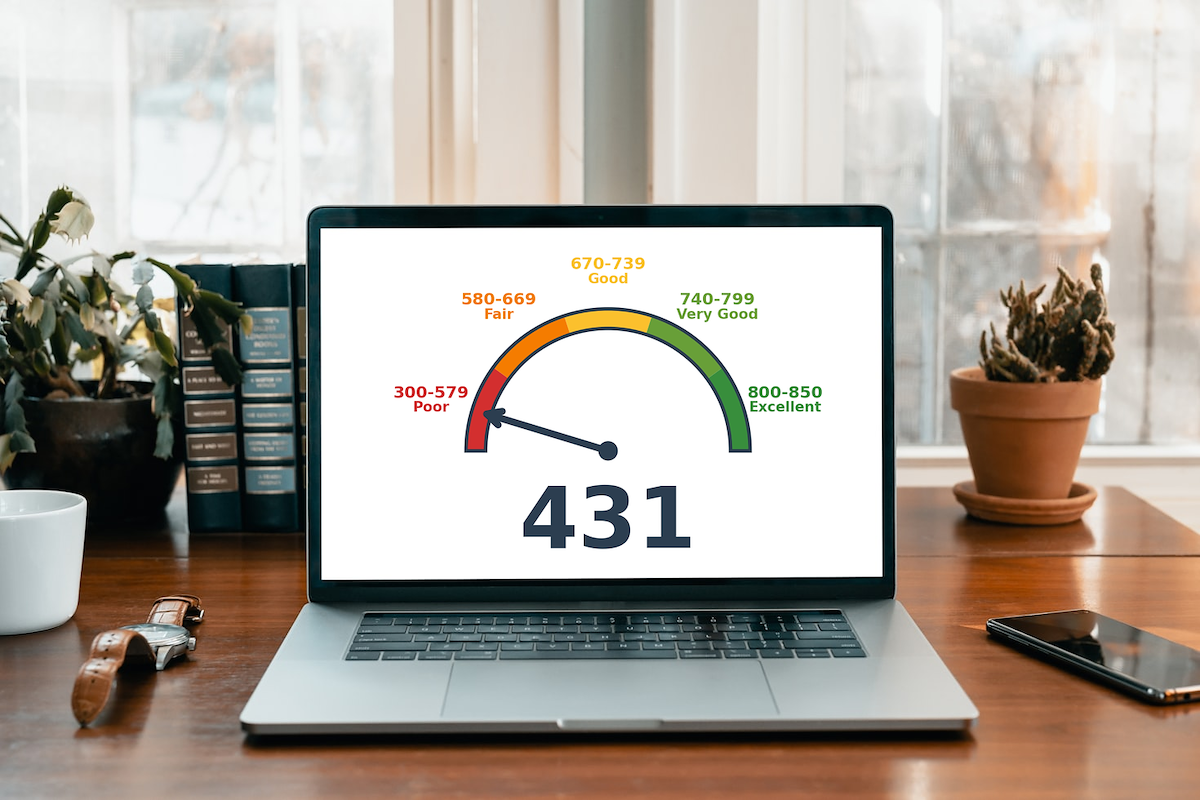
Kudos has partnered with CardRatings and Red Ventures for our coverage of credit card products. Kudos, CardRatings, and Red Ventures may receive a commission from card issuers. Kudos may receive commission from card issuers. Some of the card offers that appear on Kudos are from advertisers and may impact how and where card products appear on the site. Kudos tries to include as many card companies and offers as we are aware of, including offers from issuers that don't pay us, but we may not cover all card companies or all available card offers. You don't have to use our links, but we're grateful when you do!
374 Credit score: What You Need to Know in 2025
July 1, 2025


TL;DR
A 374 credit score is an opportunity to build a stronger financial foundation, though it does present some initial hurdles. According to the FICO model, this score falls into the “Poor” category, signaling a clear path for growth and improvement.
What Does a 374 Credit Score Mean?
A credit score of 374 falls into the "poor" category of the FICO Score range, which spans from 300 to 850. This score signals to lenders that you are a high-risk borrower, significantly impacting your financial life. You'll likely face rejections for most loans and credit cards. Any approved credit will probably come with very high interest rates and unfavorable terms, making borrowing expensive.
While a 374 score presents considerable challenges, it is not a permanent situation. It reflects past financial behavior but doesn't have to dictate your future. Understanding what led to this score is the first step toward rebuilding. Over time, improving your score is an achievable goal that can unlock better financial opportunities.
Who Has a 374 Credit Score?
While age isn't a direct factor in credit score calculations, there is a clear trend of scores improving over time. According to 2023 Experian data, the average FICO score tends to rise with each generation:
- Generation Z (ages 18-26): 680
- Millennials (ages 27-42): 690
- Generation X (ages 43-58): 709
- Baby Boomers (ages 59-77): 745
- Silent Generation (ages 78+): 760
Credit Cards With a 374 Credit Score
A credit score of 374 is considered very poor, placing you in the lowest range of creditworthiness. Consequently, lenders will view you as a high-risk borrower, making it extremely challenging to qualify for traditional unsecured credit cards. Your options will likely be restricted to secured credit cards that require a cash deposit or certain subprime cards that often come with high fees and interest rates.
Kudos uses AI-powered tools to help you find a suitable card from its database of nearly 3,000 options based on your personal preferences and financial needs. The platform also offers insights into how applying for a new card may impact your credit score, helping you choose a card to build your credit responsibly.
Auto Loans and a 374 Credit Score
A 374 credit score places you in the deep subprime category, which lenders view as a high risk. Consequently, while approval is still possible, you will face extremely high interest rates that significantly increase the total cost of your car.
According to a 2025 automotive finance report, here are the average interest rates for different credit score brackets:
- Super-prime (781-850): 5.25% for new cars and 7.13% for used cars.
- Prime (661-780): 6.87% for new cars and 9.36% for used cars.
- Non-prime (601-660): 9.83% for new cars and 13.92% for used cars.
- Subprime (501-600): 13.18% for new cars and 18.86% for used cars.
- Deep subprime (300-500): 15.77% for new cars and 21.55% for used cars.
Mortgages at a 374 Credit Score
Unfortunately, a 374 credit score is highly unlikely to qualify you for any mainstream mortgage. Even government-backed programs with more lenient standards have higher minimums; for example, FHA loans generally require a score of at least 500 with a 10% down payment. According to mortgage requirements, scores this low fall well below the threshold for nearly all lenders, making loan denial a near certainty.
If you could find a subprime lender, a low score would lead to the least favorable terms possible. This means facing significantly higher interest rates and fees, which dramatically increases the total cost of the loan. Lenders would also impose strict underwriting, cap the amount you can borrow, and likely require a much larger down payment to offset their risk.
What's in a Credit Score?
Figuring out what goes into your credit score can feel like trying to solve a complex puzzle, but it generally boils down to a handful of key elements. The most common factors include:
- Your payment history, which tracks whether you pay your bills on time, is the most significant factor.
- Credit utilization, or the amount of credit you're using compared to your total available credit, also plays a major role.
- The length of your credit history demonstrates your experience with managing credit over time.
- Having a healthy mix of different types of credit, such as credit cards and installment loans, can positively impact your score.
- Finally, recent credit inquiries, which occur when you apply for new credit, are also taken into account.
How to Improve Your 374 Credit Score
Don't be discouraged by a 374 credit score; with consistent effort and the right strategy, it's entirely possible to rebuild your financial standing. There are several proven methods you can use to see meaningful changes, often within just a few months.
- Establish Automatic Bill Payments. Since payment history is the most significant factor in your score, setting up automatic payments ensures you never miss a due date. This consistent, on-time payment history is the foundation for rebuilding damaged credit.
- Apply for a Secured Credit Card. A secured card requires a cash deposit as collateral, making it accessible for those with poor credit. Making regular, on-time payments on this card will be reported to credit bureaus, helping you establish a positive track record.
- Reduce Your Credit Utilization. This ratio compares your credit card balances to your total credit limits, and keeping it below 30% is ideal. Paying down balances or even making multiple payments per month can lower your utilization and show lenders you can manage credit responsibly.
- Monitor Your Credit Reports. Errors on your credit report can unfairly drag down your score, so it's crucial to check them regularly. You can obtain free reports and dispute any inaccuracies you find, which can provide a direct boost to your score once corrected.
For help managing your cards and maximizing their value as you rebuild your credit, the Kudos browser extension can be an invaluable tool.

Supercharge Your Credit Cards
Experience smarter spending with Kudos and unlock more from your credit cards. Earn $20.00 when you sign up for Kudos with "GET20" and make an eligible Kudos Boost purchase.
Editorial Disclosure: Opinions expressed here are those of Kudos alone, not those of any bank, credit card issuer, hotel, airline, or other entity. This content has not been reviewed, approved or otherwise endorsed by any of the entities included within the post.























.webp)
















